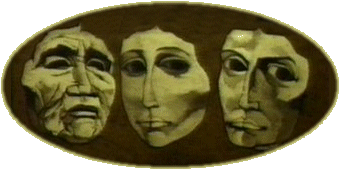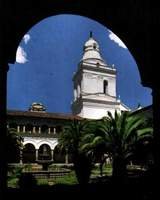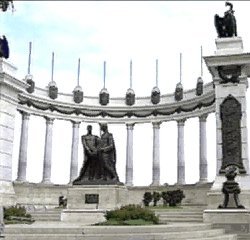|
|
Ecuador: History
|


|
|

|
|
 bout 3000 years before Christ, tribes that inhabited the coastal areas of what is now Ecuador, were baking clay into figures and utensils that represent the earliest manifestations of cultures developing in this land. By the eleventh century of our era, a strong group known as the Shyris dominated most of the territory from their main stronghold, a place named Quito. The southern part of the country was held by another group, the Cañaris. bout 3000 years before Christ, tribes that inhabited the coastal areas of what is now Ecuador, were baking clay into figures and utensils that represent the earliest manifestations of cultures developing in this land. By the eleventh century of our era, a strong group known as the Shyris dominated most of the territory from their main stronghold, a place named Quito. The southern part of the country was held by another group, the Cañaris.
During the 15th Century, the Inca Empire was expanding from Cuzco and Emperor Tupac Yupanqui conquered the Cañaris' land. His son Huayna Capac continued the Inca expansion and overtook the Shyris, settling in Quito around year 1500, marrying the daughter of the last Shyri, princess Paccha. In 1525, Huayna Capac returned to Cuzco and died there. The Empire was then divided between Huayna Capa's two sons, Huascar who remained in Cuzco, and Atahualpa, son of Paccha, who ruled the northern part of the Empire from headquarters in Quito. A year later, a civil war broke out between the brothers. In 1532 Atahualpa executed Huascar and reunited the Empire. On the 15th of November of the same year, as Atahualpa was enjoying his triumph in the town of Cajamarca (northern Peru) the Spanish conqueror Francisco Pizarro with 200 men ambushed the Emperor and took him as hostage. Notwithstanding a hefty ransom paid to the Spaniards, Atahualpa was executed and the Inca Empire fell into Spanish Colonial rule. In the meantime, Atahaulpa's lieutenant, Rumiñahui, resisted in the North until 1534 when he burned down the city of Quito before surrendering it to the Spaniard Sebastián de Benalcazar, who then re-founded the city under the name of San Francisco de Quito on the 6th of December of 1534.
|
|
Spanish Colonial rule lasted for almost 300 years. Quito was first assigned as an administrative dependency of the Vice-royalty of Lima, and later of that of Nueva Granada (Bogotá). The area was rich in agriculture and heavily populated, resulting in a very important center for the establishment of religious and cultural activities, as attested by the richness of the art and architecture which flourished in Quito and the rest of the towns of the country.
|

|
|
|
The 18th Century saw the decline of the Spanish Empire, and the Colonies grew increasingly restless with its rule. At the end of that century the French Revolution and the North American Independence injected new ideas about self-rule amongst South Americans. On August 10, 1809, Quito became the first Spanish Colony to declare its independence from the Crown. One year later, on August 2, the Spanish regained control and executed most of the rebel leaders. A few years later the Liberator Simón Bolívar defeated the Spaniards in Carabobo sealing the independence of Venezuela, advanced to Bogotá winning the battle of Boyacá, and further sent his troops under the command of General Antonio José de Sucre to fight the Spanish armies in Quito. The 24th of May of 1822, the battle of Pichincha settled the issue in favor of independence. A couple of months later, Bolívar entered triumphantly in Quito where he met Manuela Sáenz, the woman who was to rule his heart for the rest of his days. From Quito, Bolívar moved to Guayaquil for a historical meeting with the Liberator of the Southern Cone of South America, San Martín, on July 26, 1822. The geo-political future of the Continent was basically decided there.
The territories of what would become Ecuador were annexed to the "Gran Colombia" a state that encompassed Venezuela, Colombia, Panama and Ecuador. Eight years later, however, many of Bolívar's dreams came to a early end, only a few months before his death. The "Department of the South" became Ecuador under the first Constitution signed in the city of Riobamba on September 23, 1830. General Juan José Flores, one of Bolívar's main lieutenants, became the First President and dominated the political scene for two decades.
|

|
|
Travel in Ecuador
General Info
Geography
Climate
Culture
Country Data
Tips for Travelers
Why Ecuador?
Travel in Ecuador with Hacienda Chillo-Jijón
Contact Hacienda Chillo-Jijón
|

|
|
History (cont.)
|


|
|
|
The political development of Ecuador during the 19th Century is marked by the same search for identity which characterized all of Latin America after the Independence, as a result of the collapse of the Spanish political edifice and the traditions that had remained so solid for three centuries. Power struggles between Liberals and Conservatives, lack of political and legal structures, and an attempt to assimilate -by trial and error- the new experiences of Democracy as mirrored from North America and Europe, resulted in dozens of weak and conflicting governments. Only from 1860 to 1875, the rule of Gabriel García Moreno contrasts with the tendency: he finally managed to unite the country and set it in the path of rapid incorporation to the technological development which was characteristic of the period in the most developed countries. However, his excessively autocratic rule and the power he vested upon the Church over the liberal movements that were rapidly growing, created a strong backlash that ended not only with his assassination, but in the return, after his death, to the instability and lack of national purpose that he had so strongly fought against.
In 1895 Eloy Alfaro, a long time dissident and guerrilla warrior, finally took over the Government and started a period of drastic political, economic, legal and social change. Alternating between constitutional rules and dictatorial practices, he introduced the country to liberal politics, carried out impressive public works, and separated the State from the Church in a move that modernized the country in many ways, but which at the same time destroyed most of the cultural, educational and public service structures that held Ecuador together. The "liberal period" which followed for almost half a century was characterized by a myriad of party-appointed governments and military dictatorships of ephemeral duration.
|

|
|
In close to two hundred years of republican life, Ecuador has never let the dream of a free society and a working democracy die: even if de-facto governments were a common occurrence until a quarter of a century ago, they have always been considered -and have always defined themselves- as transitional remedies in the search of more stable solutions.
|

|
|
A most charismatic personality, José María Velasco Ibarra, began in 1935 a populist career centered on the fight for the validation of the popular wish through free elections. Elected President five times by immense popular support, he only once (from 1952 to 1956) managed to complete his mandate. Toppled each time as a result of economic and political crises he left the country only to return a few years later for landslide electoral victories. From 1948 to 1961 Ecuador enjoyed a period of democratic maturity and general stability. Since then, and until 1979, only two constitutional governments alternated with military rule. |

|
|
|
During this period, vast reserves of petroleum were discovered in the Amazon jungle area. The face of the country was never the same again: rapid development of the physical infrastructure was accompanied by gross mismanagement of development policies. A peaceful, mostly-agrarian society was rapidly urbanized, the economy became the ring of divergent political experiments, and industrial development, important as it was, never achieved expected goals.
Democracy was reinstalled in 1979 and has lasted ever since, in spite of recent institutional crises. President Jaime Roldós was elected that year, but died in a plane crash in 1981. His Vice-president, the Christian-democrat Oswaldo Hurtado completed the period until 1984. León Febres-Cordero, a strong liberal, ruled from 1984 to 1988, and was succeeded by a social-democrat, Rodrigo Borja, for a term lasting until 1992 and characterized by high inflation rates. A conservative government, led by President Sixto Durán-Ballén managed to control the economy, but the success was jeopardized by a short but costly border war with Peru in 1995 and by relentless opposition in Congress. A hard-core populist, Abdalá Bucarám, elected in 1996 was declared unfit to govern by Congress less than a year later while an interim President, Fabián Alarcón, was named to replace him. Another Christian-democrat, Jamil Mahuad, elected in 1998, resigned in January 2000 amidst a profound financial crisis, letting his Vice-president, Gustavo Noboa, take over within the frame of constitutional succession. In elections held at the end of 2002, Lucio Gutierrez, a former army Colonel who was involved in the uprisings of January 2000, was elected President and took over in January 2003.
|
|
|
|
Sponsored by :
 Hacienda Chillo-Jijón
Hacienda Chillo-Jijón
Quito, Ecuador
** Travel **
Deluxe
countryside lodging at
Hacienda Chillo-Jijón


ECUADOR
Travel in Ecuador
General Info
Geography
Climate
Ecuadorian Culture
Tips for Travelers
Country Data
Travel Links
Ecuador Explorer
Haciendas
Ecuador Explorer
Hotels in Quito
Ecuador Explorer
Tour Operators
Lonely Planet's
"Destination Ecuador"
Planet Ecuador
About Ecuador
Country Walkers
Additional Info
CNN Weather
Quito
CNN Weather
Galapagos
Country's
Statistics
|